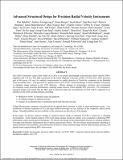Advanced structural design for precision radial velocity instruments
Author(s)
Frebel, Anna L.
DownloadAdvanced structural.pdf (3.937Mb)
PUBLISHER_POLICY
Publisher Policy
Article is made available in accordance with the publisher's policy and may be subject to US copyright law. Please refer to the publisher's site for terms of use.
Terms of use
Metadata
Show full item recordAbstract
The GMT-Consortium Large Earth Finder (G-CLEF) is an echelle spectrograph with precision radial velocity (PRV) capability that will be a first light instrument for the Giant Magellan Telescope (GMT). G-CLEF has a PRV precision goal of 40 cm/sec (10 cm/s for multiple measurements) to enable detection of Earth-like exoplanets in the habitable zones of sun-like stars. This precision is a primary driver of G-CLEF’s structural design. Extreme stability is necessary to minimize image motions at the CCD detectors. Minute changes in temperature, pressure, and acceleration
environments cause structural deformations, inducing image motions which degrade PRV precision. The instrument’s structural design will ensure that the PRV goal is achieved under the environments G-CLEF will be subjected to as installed on the GMT azimuth platform, including:
• Millikelvin (0.001 °K) thermal soaks and gradients
• 10 millibar changes in ambient pressure
• Changes in acceleration due to instrument tip/tilt and telescope slewing
Carbon fiber/cyanate composite was selected for the optical bench structure in order to meet performance goals. Low coefficient of thermal expansion (CTE) and high stiffness-to-weight are key features of the composite optical bench design. Manufacturability and serviceability of the instrument are also drivers of the design.
In this paper, we discuss analyses leading to technical choices made to minimize G-CLEF’s sensitivity to changing
environments. Finite element analysis (FEA) and image motion sensitivity studies were conducted to determine PRV
performance under operational environments. We discuss the design of the optical bench structure to optimize stiffnessto-weight
and minimize deformations due to inertial and pressure effects. We also discuss quasi-kinematic mounting of
optical elements and assemblies, and optimization of these to ensure minimal image motion under thermal, pressure, and
inertial loads expected during PRV observations.
Date issued
2016-10Department
Massachusetts Institute of Technology. Department of Physics; MIT Kavli Institute for Astrophysics and Space ResearchJournal
Proceedings of SPIE--the Society of Photo-Optical Instrumentation Engineers
Publisher
Society of Photo-Optical Instrumentation Engineers (SPIE)
Citation
Baldwin, Dan et al. “Advanced Structural Design for Precision Radial Velocity Instruments.” Ed. Ramón Navarro and James H. Burge. Advances in Optical and Mechanical Technologies for Telescopes and Instrumentation II (June 26, 2016.) © 2016 Society of Photo-Optical Instrumentation Engineers (SPIE)
Version: Final published version
ISSN
0277-786X
1996-756x